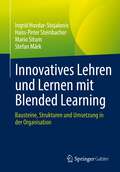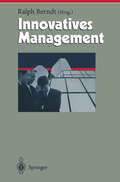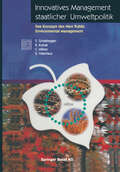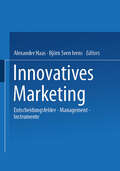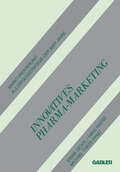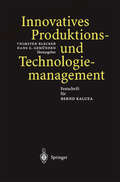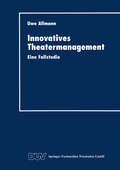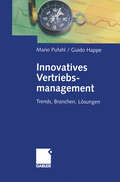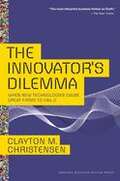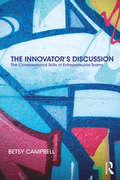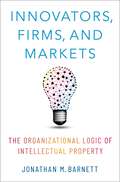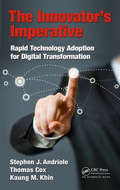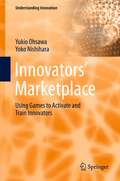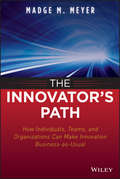- Table View
- List View
Innovatives Lehren und Lernen mit Blended Learning: Bausteine, Strukturen und Umsetzung in der Organisation
by Ingrid Hovdar-Stojakovic Hans-Peter Steinbacher Mario Situm Stefan MärkWie kann Blended Learning genutzt werden, um organisationales Lernen zu fördern und Wissens- und Kompetenzerwerb effizient zu gestalten? Dieses Buch richtet sich an alle, die in einem Unternehmens- oder Hochschulkontext Lernszenarien planen, konzipieren und durchführen. Zudem richtet es sich an Personalverantwortliche, welche Aus- und Weiterbildung im eigenen Unternehmen für Mitarbeiter zeitgemäß auf- und umsetzen möchten. Erfahren Sie, wie man Blended Learning so gestaltet, dass Wissen je nach Inhalt, Problemstellung, Schwierigkeitsgrad und Zielgruppe im Unternehmen strukturiert und systematisiert an die anvisierten Zielgruppen weitergegeben wird. Dabei gehen die Autoren versiert und praxisbezogen insbesondere auf Kompetenzerwerb und Learning Outcomes ein, damit in der Umsetzung der größtmögliche Lernerfolg erzielt und gemessen werden kann.
Innovatives Lieferantenmanagement: Wertschöpfung in globalen Lieferketten
by Marc HelmoldGlobalisierung, Digitalisierung, weltweite Lieferketten und die Corona-Pandemie haben in Unternehmen zu einer stärkeren Betrachtung von Wertschöpfungsketten geführt. Durch Leistungsverlagerungen auf teilweise konkurrierende Lieferantennetzwerke entstehen neue Leitbilder, Strategien und Abläufe. Der Fokus in der Zukunft liegt somit schon lange nicht mehr nur auf der Hebung unternehmensinterner Kostenvorteile, sondern viel mehr im Informationsaustausch, in stabilen Lieferketten und der Ausschöpfung globaler unternehmensübergreifender Potenziale.Dieses Buch zeigt anhand innovativer, digitaler und strategischer Beispiele, wie ein erfolgreiches Lieferantenmanagement funktionieren und agieren muss.
Innovatives Management (Herausforderungen an das Management #7)
by Ralph BerndtDie Rahmenbedingungen für wirtschaftliche Prozesse haben sich wesentlich gewandelt. Beispielhaft zu nennen sind die extrem schnelle Entwicklung der Kommunikationstechnologien, die erheblichen Konzentrationsprozesse oder das hybride Konsumentenverhalten. Daher sind - für alle Teilgebiete der Unternehmensführung - innovative Management-Ansätze erforderlich. Führende Fachvertreter aus Europa und den USA untersuchen in diesem Band, welche Ansätze für ein innovatives Management herangezogen werden können.
Innovatives Management staatlicher Umweltpolitik: Das Konzept des New Public Environmental Management (Themenhefte Schwerpunktprogramm Umwelt)
by S. Schaltegger R. Kubat C. Hilber S. VaterlausInnovatives Marketing: Entscheidungsfelder - Management - Instrumente
by Alexander Haas Bjö Sven IvensDie Autoren bieten dem Leser einen Überblick über die unterschiedlichen neuen Wege, die in den verschiedenen Teilbereichen des Marketing derzeit beschritten werden. Ausgewiesene Experten aus Wissenschaft und Praxis berichten über aktuelle Trends, Innovationen und Veränderungen im Marketing: Grundlegende Aspekte, Konsumentenverhalten, Marketingprozesse, Marketinginstrumente, Management, Institutionen.
Innovatives Produktions-und Technologiemanagement: Festschrift für Bernd Kaluza
by Thorsten Blecker Hans G. GemündenDie Bedeutung des Produktions- und Technologiemanagement für eine erfolgreiche Positionierung von Unternehmen steigt ständig, unterliegt jedoch sowohl aufgrund aktueller technischer Entwicklungen als auch aufgrund eines verschärften Wettbewerbs in den letzten Jahren deutlich veränderten Rahmenbedingungen. International renommierte Autoren untersuchen in diesem Buch die verschiedenen Aspekte einer innovativen Gestaltung des Produktions- und Technologiemanagements, die Auswirkungen und Anforderungen, die ein innovatives Produktions- und Technologiemanagement an andere betriebliche Funktionen stellt, sowie die Innovationsaspekte des Strategischen Managements und von Dienstleistungsunternehmen. Das Buch richtet sich an Führungskräfte und Berater sowie Wissenschaftler mit den Schwerpunkten Strategische Unternehmensführung oder Produktions-, Innovations- und Technologiemanagement.
Innovatives Prozessmanagement als Erfolgsfaktor im OP-Bereich eines Universitätsklinikums
by Matthias JandaDer wachsende Effizienzdruck im Gesundheitswesen wird mittel- bis langfristig zu einer Konsolidierung der Krankenhauslandschaft führen. Die Operationsabteilung eines Krankenhauses, gekennzeichnet durch eine überdurchschnittliche Erlösrelevanz bei gleichzeitig hohem Ressourceneinsatz, rückt dabei durch ihren wesentlichen Wertschöpfungsbeitrag zunehmend in den Fokus ökonomischer Betrachtungen. Dieses Buch beschäftigt sich mit der Frage, wie der OP-Bereich durch Maßnahmen zur Prozessentwicklung und -steuerung erfolgswirksam gestaltet werden kann. Es beschreibt dabei am Beispiel eines universitären Maximalversorgers praxisrelevant und detailliert die zur Optimierung der Prozesse durchgeführten Arbeitsschritte unter Darstellung der verwendeten Prozessmodelle. Durch anschließende Analyse prozessrelevanter Leistungskennzahlen kann über einen Dreijahreszeitraum gezeigt werden, welchen positiven Beitrag der operative Bereich zum Unternehmenserfolg eines Krankenhauses durch das systematische Ausschöpfen von Verbesserungspotentialen unter Wahrung von Patientensicherheit sowie der Mitarbeiterzufriedenheit leisten kann.
Innovatives Theatermanagement: Eine Fallstudie
by Uwe AllmannDie konsequente Anwendung moderner Methoden und Instrumente der Unternehmensführung verspricht für Theater neue Möglichkeiten der Rationalisierung und Effizienzsteigerung, die letztlich auch den Optionen der künstlerischen Arbeit eines Theaters zugutekommen.
Innovatives und digitales Marketing in der Praxis: Insights, Strategien und Impulse für Unternehmen
by Christian Lucas Gabriele SchusterDieses Buch liefert einen Überblick über neue Einsatzmöglichkeiten und Wirkmechanismen von digitalem Marketing. Es gibt vielfältige Impulse und zeigt anhand eines breiten Themenportfolios, welche Strategien sich für die praktische Anwendung in der Wirtschaft eignen. Die Autor:innen, allesamt Hochschuldozierende und praxiserfahrene Marketingexpert:innen, betrachten dabei die Auswirkungen der kontinuierlichen Vernetzung und Digitalisierung im gesamten Marketingprozess – und geben Antworten auf folgende Fragen: Welche Auswirkungen hat die Digitalisierung auf die Kund:innen? Wie emotionalisiert man Kundenbeziehungen und wie sieht eine erfolgreiche Customer Journey aus? Welche Potenziale haben Open Innovation, Growth Hacking, Blockchain und Künstliche Intelligenz im Marketing? Was gilt es bei E-Commerce-Strategien und beim Dynamic Pricing zu beachten? Was ist eine Corporate Digital Responsibility und welche Bedeutung haben Corporate Podcasts? Was müssen Unternehmen in besonderen Segmenten wie im B2B oder auch bei der Zielgruppe 50+ heute beachten? Ein leicht verständliches und praxisnahes Werk, das Marketingverantwortliche in Unternehmen in die Lage versetzt, gezielt dort nachzusteuern, wo sie gerade akuten Bedarf haben. Mit Beiträgen von:Elisa Dorothee Adam Christoph Albers Prof. Dr. Josef Arweck Prof. Dr. Thomas Bolz Prof. Dr. Georg Bouché Simon Ens Dr. Eva Ghazari-ArndtProf. Dr. Maik Günther Prof. Dr. Nele Hansen Dr. Natascha Hebestreit Prof. Dr. Claudia Hess Prof. Dr. Dr. Dietmar Janetzko Prof. Dr. Marion Kalteis Prof. Dr. Jan Thido Karlshaus Prof. Dr. Anna Klein Prof. Dr. Ralf Kneuper Prof. Dr. Cordula KreuzenbeckProf. Dr. Alexandra Kühte Prof. Dr. Sibylle Kunz Prof. Dr. Rico ManßProf. Dr. Michaela Moser Prof. Dr. Susanne O’Gorman Prof. Dr. Jochen Panzer Prof. Dr. Sven Pastowski Prof. Dr. Jan Pieper Prof. Dr. Jonas Polfuß Prof. Dr. Katharina-Maria Rehfeld Prof. Dr. Verena Renneberg Prof. Dr. Angela Rohde Prof. Dr. Uta Scheunert Prof. Dr. Daniel Schmid Prof. Dr. Benjamin Krischan Schulte Prof. Dr. Carsten Skerra Prof. Dr. Felix Wölfle Prof. Dr. Lisa-Charlotte Wolter Prof. Dr. Matthias Zeisberg Prof. Dr. Ina zur Oven-Krockhaus Prof. Dr. Tanja Zweigle
Innovatives Vertriebsmanagement: Trends, Branchen, Lösungen
by Mario Pufahl Guido HappeDieses Buch liefert einen Kompass für den Dschungel neuer Vertriebstrends, -methoden und -technologien. Die Leser erfahren, welche zehn Trends den Vertrieb in Zukunft bestimmen und mit welchen Managementmethoden sie die Herausforderungen am besten bewältigen. Konkrete Beispiele aus unterschiedlichen Branchen wie Banken, Energie, IT-Dienstleistung, Konsumgüter und Luftfahrt zeigen, wie die Umsetzung in die Praxis gelingt und Probleme gelöst werden können.
Innovatoren: Individuen im Innovationsmanagement
by Martina MansfeldMartina Mansfeld zeigt wesentliche Persönlichkeitsmerkmale von Innovatoren in Unternehmen auf und legt dar, wie sich die Persönlichkeitsprofile verschiedener Innovatorenrollen voneinander unterscheiden. Als Datenbasis verwendet die Autorin 190 Fragebögen mit Mitarbeitern aus forschungsintensiven Industrien.
Innovatorenorientierte Akzeptanzforschung bei innovativen Medientechnologien
by Knut SchlohmannModell ist ein akzeptanztheoretisches, das neben betriebswirtschaftlichen insbesondere Erkenntnisse der Medien- und Kommunikationswissenschaft berücksichtigt. Nach der Sichtung der verfügbaren Literatur aus Betriebswirtschaftslehre, Medien- und Kommunikationswissenschaft sowie Sozialpsychologie wurden erste Thesen formuliert und anhand qualitativer Interviews mit Experten und Nutzern validiert. Im Fokus stand hierbei die Gewährleistung einer möglichst vollständigen Erfassung der Determinanten der Akzeptanz. Daran anschließend wurde das Modell (Strukturgleichungsmodell) entwickelt und anhand einer quantitativen Studie (Online-Befragung) empirisch überprüft, bei der als Beispiel einer innovativen Medientechnologie das interaktive Fernsehen präsentiert wurde. Die Analyse erfolgte mittels multivariater Verfahren (Faktorenanalyse, AMOS). Die empirische Analyse bestätigte das Modell und die Determinanten der Akzeptanz innovativer Medientechnologien.
The Innovator's Dilemma: When New Technologies Cause Great Firms To Fail (Management Of Innovation And Change Ser.)
by Clayton M. ChristensenNamed one of 100 Leadership & Success Books to Read in a Lifetime by Amazon Editors An innovation classic. From Steve Jobs to Jeff Bezos, Clay Christensen's work continues to underpin today's most innovative leaders and organizations. The bestselling classic on disruptive innovation, by renowned author Clayton M. Christensen. His work is cited by the world's best-known thought leaders, from Steve Jobs to Malcolm Gladwell. In this classic bestseller-one of the most influential business books of all time-innovation expert Clayton Christensen shows how even the most outstanding companies can do everything right-yet still lose market leadership. Christensen explains why most companies miss out on new waves of innovation. No matter the industry, he says, a successful company with established products will get pushed aside unless managers know how and when to abandon traditional business practices. Offering both successes and failures from leading companies as a guide, The Innovator's Dilemma gives you a set of rules for capitalizing on the phenomenon of disruptive innovation. Sharp, cogent, and provocative-and consistently noted as one of the most valuable business ideas of all time-The Innovator's Dilemma is the book no manager, leader, or entrepreneur should be without.
The Innovator’s Discussion: The Conversational Skills of Entrepreneurial Teams
by Betsy CampbellThis book describes the conversational competencies that enable innovative entrepreneurial teams to create new products and ventures, and it presents several exercises and games to help readers master these conversational moves. Based on 6 years of detailed empirical analysis of teams at the forefront of technological breakthroughs and new venture creation, this book shows you how high-performance teams verbally accomplish their work. Through engaging examples, exercises, and descriptions, it enables entrepreneurs to develop the conversational competencies that can help them create new products and ventures. The book includes a technique for making interpretation visible that enables teams to navigate pivots in the innovation process. It also includes the materials and instructions for the Toasted Marshmallow game designed to help entrepreneurial teams fail forward. The Innovator’s Discussion enables readers and their team mates to build a conversational advantage. The reader will gain both a practical and theoretical understanding of the role of conversation in the context of entrepreneurial work. It is invaluable for aspiring and established entrepreneurs as well as for educators and those wanting to learn more about entrepreneurship, innovation, and high-performance teams.
The Innovator’s Discussion: The Conversational Skills of Entrepreneurial Teams
by Betsy CampbellThis book describes the conversational competencies that enable innovative entrepreneurial teams to create new products and ventures, and it presents several exercises and games to help readers master these conversational moves. Based on 6 years of detailed empirical analysis of teams at the forefront of technological breakthroughs and new venture creation, this book shows you how high-performance teams verbally accomplish their work. Through engaging examples, exercises, and descriptions, it enables entrepreneurs to develop the conversational competencies that can help them create new products and ventures. The book includes a technique for making interpretation visible that enables teams to navigate pivots in the innovation process. It also includes the materials and instructions for the Toasted Marshmallow game designed to help entrepreneurial teams fail forward. The Innovator’s Discussion enables readers and their team mates to build a conversational advantage. The reader will gain both a practical and theoretical understanding of the role of conversation in the context of entrepreneurial work. It is invaluable for aspiring and established entrepreneurs as well as for educators and those wanting to learn more about entrepreneurship, innovation, and high-performance teams.
The Innovator's Field Guide: Market Tested Methods and Frameworks to Help You Meet Your Innovation Challenges
by Peter Skarzynski David CrosswhiteA step-by-step guide to successfully transforming any organization It is well recognized that succeeding at innovation is fundamental in today's hyper-competitive global marketplace. It is the only way to outperform current and emerging competitors sustainably. But what we call “innovation” is messy and difficult and too often lacks the rigor and discipline of other management processes. The Innovator's Field Guide: Market Tested Methods and Frameworks to Help You Meet Your Innovation Challenges changes that. It is a practical guide that moves beyond the “why” to the “how” of making innovation happen, for leaders and practitioners inside organizations of all sizes. Written by two pioneers in the field of embedding innovation in organization, The Innovator's Field Guide focuses on the most pressing innovation problems and specific challenges innovation leaders will face and offers concrete solutions, tools, and methods to overcome them. Each chapter describes a specific innovation challenge and details proven ways to address that challenge Includes practical ideas, techniques, and leading practices Describes common obstacles and offers practical solutions Any leader or professional who needs concrete solutions—right now—to the critical challenges of innovation will find invaluable aid in the practical, easy-to-understand, and market-tested approaches of The Innovator's Field Guide.
The Innovator's Field Guide: Market Tested Methods and Frameworks to Help You Meet Your Innovation Challenges
by Peter Skarzynski David CrosswhiteA step-by-step guide to successfully transforming any organization It is well recognized that succeeding at innovation is fundamental in today's hyper-competitive global marketplace. It is the only way to outperform current and emerging competitors sustainably. But what we call “innovation” is messy and difficult and too often lacks the rigor and discipline of other management processes. The Innovator's Field Guide: Market Tested Methods and Frameworks to Help You Meet Your Innovation Challenges changes that. It is a practical guide that moves beyond the “why” to the “how” of making innovation happen, for leaders and practitioners inside organizations of all sizes. Written by two pioneers in the field of embedding innovation in organization, The Innovator's Field Guide focuses on the most pressing innovation problems and specific challenges innovation leaders will face and offers concrete solutions, tools, and methods to overcome them. Each chapter describes a specific innovation challenge and details proven ways to address that challenge Includes practical ideas, techniques, and leading practices Describes common obstacles and offers practical solutions Any leader or professional who needs concrete solutions—right now—to the critical challenges of innovation will find invaluable aid in the practical, easy-to-understand, and market-tested approaches of The Innovator's Field Guide.
Innovators, Firms, and Markets: The Organizational Logic of Intellectual Property
by Jonathan M. BarnettConventional wisdom holds that robust enforcement of intellectual property (IP) right suppress competition and innovation by shielding incumbents against the entry threats posed by smaller innovators. That assumption has driven mostly successful efforts to weaken US patent protections for over a decade. This book challenges that assumption. In Innovators, Firms, and Markets, Jonathan M. Barnett confronts the reigning policy consensus by analyzing the relationship between IP rights, firm organization, and market structure. Integrating tools and concepts from IP and antitrust law, institutional economics, and political science, real-world understandings of technology markets, and empirical insights from the economic history of the US patent system, Barnett provides a novel framework for IP policy analysis. His cohesive framework explains how robust enforcement of IP rights enables entrepreneurial firms, which are rich in ideas but poor in capital, to secure outside investment and form the cooperative relationships needed to transform a breakthrough innovation into a marketable product. The history of the US patent system and firms' lobbying tendencies show that weakening patent protections removes a critical tool for entrants to challenge incumbents that enjoy difficult-to-match commercialization and financing capacities. Counterintuitively, the book demonstrates that weak IP rights are often the best entry barrier the state can provide to protect entrenched incumbents against disruptive innovators. By challenging common assumptions and offering a powerful integrated framework for understanding how innovation happens and the law's role in that process, Barnett's Innovators, Firms, and Markets provides important insights into how IP law shapes our economy.
Innovators, Firms, and Markets: The Organizational Logic of Intellectual Property
by Jonathan M. BarnettConventional wisdom holds that robust enforcement of intellectual property (IP) right suppress competition and innovation by shielding incumbents against the entry threats posed by smaller innovators. That assumption has driven mostly successful efforts to weaken US patent protections for over a decade. This book challenges that assumption. In Innovators, Firms, and Markets, Jonathan M. Barnett confronts the reigning policy consensus by analyzing the relationship between IP rights, firm organization, and market structure. Integrating tools and concepts from IP and antitrust law, institutional economics, and political science, real-world understandings of technology markets, and empirical insights from the economic history of the US patent system, Barnett provides a novel framework for IP policy analysis. His cohesive framework explains how robust enforcement of IP rights enables entrepreneurial firms, which are rich in ideas but poor in capital, to secure outside investment and form the cooperative relationships needed to transform a breakthrough innovation into a marketable product. The history of the US patent system and firms' lobbying tendencies show that weakening patent protections removes a critical tool for entrants to challenge incumbents that enjoy difficult-to-match commercialization and financing capacities. Counterintuitively, the book demonstrates that weak IP rights are often the best entry barrier the state can provide to protect entrenched incumbents against disruptive innovators. By challenging common assumptions and offering a powerful integrated framework for understanding how innovation happens and the law's role in that process, Barnett's Innovators, Firms, and Markets provides important insights into how IP law shapes our economy.
The Innovator’s Imperative: Rapid Technology Adoption for Digital Transformation
by Stephen J Andriole Thomas Cox Kaung M. KhinThe pace of technological change is accelerating, hyper competition is growing, opportunities for business model disruption are exploding, and comprehensive cloud delivery is readily available. These factors challenge every aspect of business technology strategy. The Innovator’s Imperative: Rapid Technology Adoption for Digital Transformation prepares twenty-first century businesses leaders for competing and leading in this disruptive digital environment. Five years of research conducted by the authors suggests that leading companies have all but abandoned the requirements analysis and modeling best practices of the twentieth century. Accordingly, the authors put forth the innovator’s imperative that contends: All companies wanting to be competitive should adopt emerging and disruptive technologies as quickly as possible, and in many cases, immediately. Technology is driving business strategy, and companies are rethinking their technology strategy, especially the governance that determines how and why technology investments are made. Based on their research the authors have developed a five-step framework for digital transformation: Model and simulate Identify high-leverage opportunities Prioritize transformational targets Identify digital opportunities Find courageous leaders The book explains each of these steps to guide business leaders in architecting digital transformation projects according to their organization’s market positions, budgets, objectives, and corporate culture. Hyper-competitive, disruptive companies are jumping across technology adoption phases without regard to any phasing whatsoever. Companies focused on digital transformation often adopt emerging technologies immediately. They have become early adopters of technologies that can impact existing—and create whole new—business models and processes. This book examines this jump into new technologies, processes, and business models to prepare twenty-first century business leaders to make that leap.
The Innovator’s Imperative: Rapid Technology Adoption for Digital Transformation
by Stephen J Andriole Thomas Cox Kaung M. KhinThe pace of technological change is accelerating, hyper competition is growing, opportunities for business model disruption are exploding, and comprehensive cloud delivery is readily available. These factors challenge every aspect of business technology strategy. The Innovator’s Imperative: Rapid Technology Adoption for Digital Transformation prepares twenty-first century businesses leaders for competing and leading in this disruptive digital environment. Five years of research conducted by the authors suggests that leading companies have all but abandoned the requirements analysis and modeling best practices of the twentieth century. Accordingly, the authors put forth the innovator’s imperative that contends: All companies wanting to be competitive should adopt emerging and disruptive technologies as quickly as possible, and in many cases, immediately. Technology is driving business strategy, and companies are rethinking their technology strategy, especially the governance that determines how and why technology investments are made. Based on their research the authors have developed a five-step framework for digital transformation: Model and simulate Identify high-leverage opportunities Prioritize transformational targets Identify digital opportunities Find courageous leaders The book explains each of these steps to guide business leaders in architecting digital transformation projects according to their organization’s market positions, budgets, objectives, and corporate culture. Hyper-competitive, disruptive companies are jumping across technology adoption phases without regard to any phasing whatsoever. Companies focused on digital transformation often adopt emerging technologies immediately. They have become early adopters of technologies that can impact existing—and create whole new—business models and processes. This book examines this jump into new technologies, processes, and business models to prepare twenty-first century business leaders to make that leap.
Innovators' Marketplace: Using Games to Activate and Train Innovators (Understanding Innovation)
by Yukio Ohsawa Yoko NishiharaThis book presents a powerful method for innovation that reinforces combinatorial and analogical thoughts, with interdisciplinary communications among stakeholders in the market. In this method called Innovators' Marketplace, two games - Innovators' Market Game and Analogy Game - accelerate the spiral of innovation with visualizing data on the connectivity of pieces of existing knowledge. Some players invent ideas by connecting and combining pre-existing knowledge, while others evaluate the ideas to decide whether or not to buy. In a joyful atmosphere created by the games, players look beyond resistance to criticism, as experiments real cases show. They will start thinking and talking about the best segment of the majority, latent requirements in the future market, and scenarios for satisfying those requirements. This process embodies the principle that an interdisciplinary combination of business actors and resources, possibly with the appearance of new actors, triggers innovation.
The Innovator's Path: How Individuals, Teams, and Organizations Can Make Innovation Business-as-Usual
by Madge M. MeyerA guide to creating and sustaining a culture of innovation focused on business value The Innovator’s Path introduces business readers to thought leader Madge M. Meyer’s unique, cross-cultural perspective on corporate innovation. The book presents eight essential disciplines (Listen, Lead, Position, Promote, Connect, Commit, Execute, and Evolve) that pave the way for individuals, teams, and organizations to continually innovate in ways that create new business value. The author overturns existing assumptions about inspiring and managing innovation, while offering new insights and practical advice for aspiring innovators and corporate leaders. Meyer demonstrates her points by telling the stories behind many of her award-winning results and adds engaging personal anecdotes to illustrate many of her points. The book also contains contributions from an extraordinary and diverse set of industry innovators. Offers new ways for cultivating a mindset and culture of results-focused innovation and business value creation Equips CEOs, CFOs, CIOs, CMOs, COOs, CTOs and aspiring innovators with proven principles and practices for leading innovation Focuses her readers' attention on the eight essential disciplines that help individuals, teams, and organizations innovate more successfully Whether your focus is on your career, your team's success, or your organization's future, The Innovator’s Path provides you with the insights, strategies, techniques, and inspiration you need to accelerate your innovation progress.
The Innovator's Path: How Individuals, Teams, and Organizations Can Make Innovation Business-as-Usual
by Madge M. MeyerA guide to creating and sustaining a culture of innovation focused on business value The Innovator’s Path introduces business readers to thought leader Madge M. Meyer’s unique, cross-cultural perspective on corporate innovation. The book presents eight essential disciplines (Listen, Lead, Position, Promote, Connect, Commit, Execute, and Evolve) that pave the way for individuals, teams, and organizations to continually innovate in ways that create new business value. The author overturns existing assumptions about inspiring and managing innovation, while offering new insights and practical advice for aspiring innovators and corporate leaders. Meyer demonstrates her points by telling the stories behind many of her award-winning results and adds engaging personal anecdotes to illustrate many of her points. The book also contains contributions from an extraordinary and diverse set of industry innovators. Offers new ways for cultivating a mindset and culture of results-focused innovation and business value creation Equips CEOs, CFOs, CIOs, CMOs, COOs, CTOs and aspiring innovators with proven principles and practices for leading innovation Focuses her readers' attention on the eight essential disciplines that help individuals, teams, and organizations innovate more successfully Whether your focus is on your career, your team's success, or your organization's future, The Innovator’s Path provides you with the insights, strategies, techniques, and inspiration you need to accelerate your innovation progress.
